Check out what Marianne Bishop has been up to lately.
Warning: It could have you getting out your beads!

Check out what Marianne Bishop has been up to lately.
Warning: It could have you getting out your beads!
Vivian Aumond-Capone feature new art on the gallery pages. Check ’em out!
New member Heather Long has images in her gallery. Check it out! You can also see what else Heather is up to on her blog (See the side column for web sites/blogs of our members.).
Sara Kelly also as new art on her gallery page. See what has been shaking her creative world.
The letters X, Y and Z and the symbols & and ? inspired the following postcards:
X is for X-ray form by Maureen Callahan
Note: The address side of Maureen’s postcard reads:
Patient name: Old Lady
Condition: Swallows Fauna
Diagnosis: Perhaps she’ll die
Admitted by: Dr. G.House Fly
Y is for Say Yes to Yellow by Lynn Chinnis
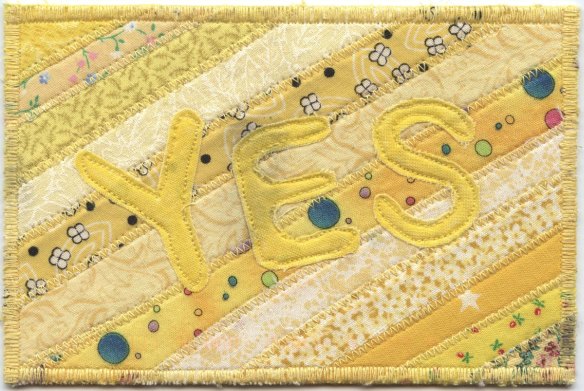 Z is for Zig-Zag by Evie Harris
Z is for Zig-Zag by Evie Harris
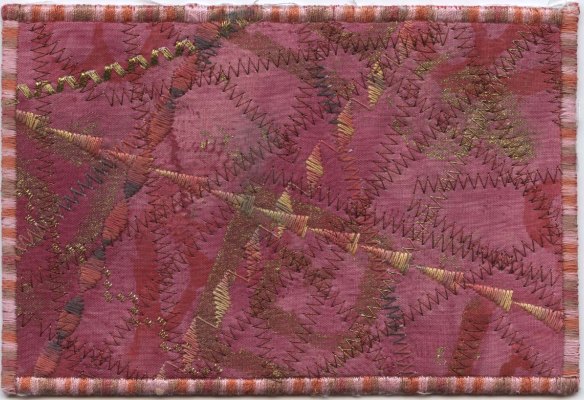 Ampersand by Suzanna Bond
Ampersand by Suzanna Bond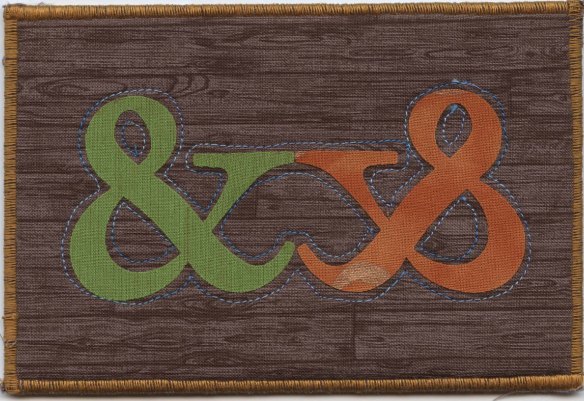 ? by Sarah Ann Smith
? by Sarah Ann Smith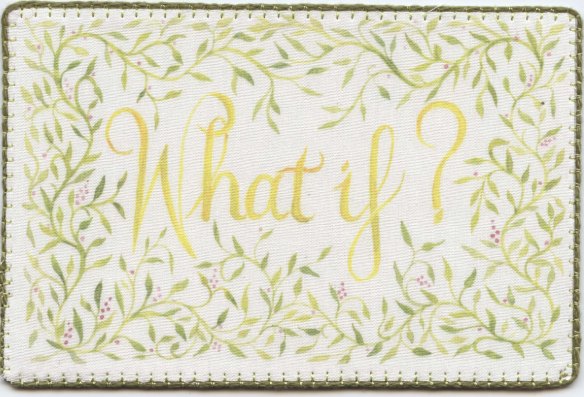 The creative person’s best question! From an original watercolor by Sarah Ann Smith.
The creative person’s best question! From an original watercolor by Sarah Ann Smith.
This trade began in 2011 and was completed in 2013. We hope you’ve enjoyed seeing what the alphabet inspired in our members as much as we enjoyed creating these fabric postcards!
Catch up on what was inspired by the entire alphabet here, here, here, here and here.
The letters S, T, U, V and W inspired the following postcards:
S is for Singer by Sarah Ann Smith
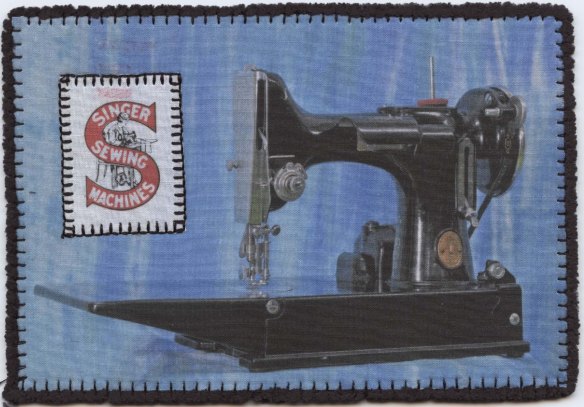 T is for Toile by Franki Kohler
T is for Toile by Franki Kohler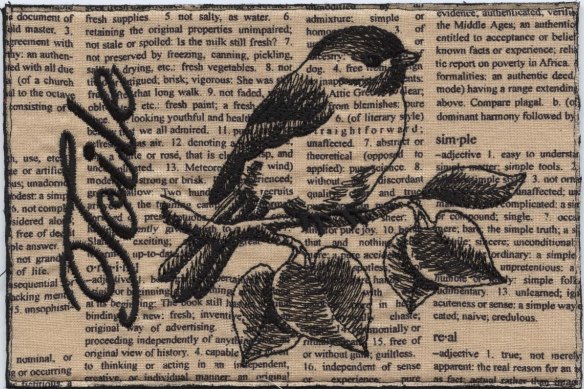 U is for Up and Away by Kay Laboda
U is for Up and Away by Kay Laboda
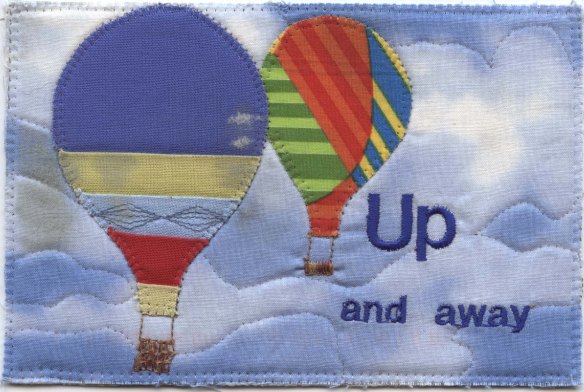 V is for Valentine (and violin!) by Sherry Boram
V is for Valentine (and violin!) by Sherry Boram
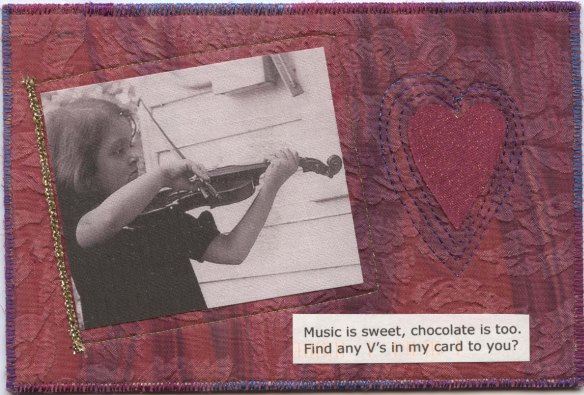 W is for a Walk in the Sand by Vivian Aumond-Capone
W is for a Walk in the Sand by Vivian Aumond-Capone
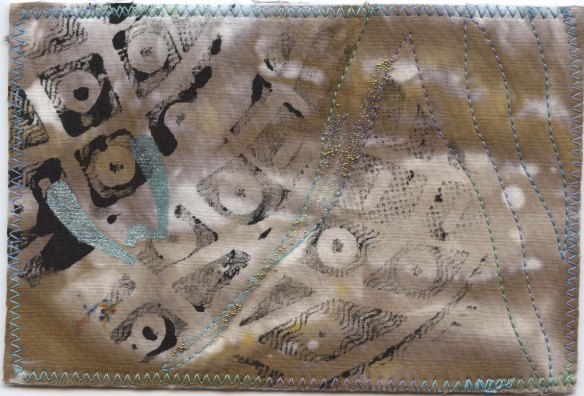 See what other letters of the alphabet inspired here, here, here, here and here.
See what other letters of the alphabet inspired here, here, here, here and here.
The letters N, O, P, Q, and R inspired the following postcards:
N is for Nasturtium by Kay Laboda
O is for Orange Oval by Lynn Chinnis
O is for O Tangle by Vivian Aumond-Capone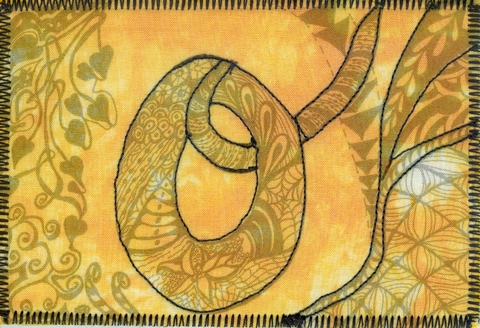 P is for Postcards! by Sherry Boram
P is for Postcards! by Sherry Boram
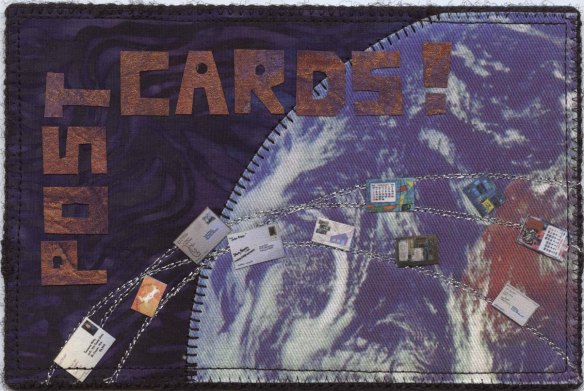 Q is for 4 Quarters by Evie Harris
Q is for 4 Quarters by Evie Harris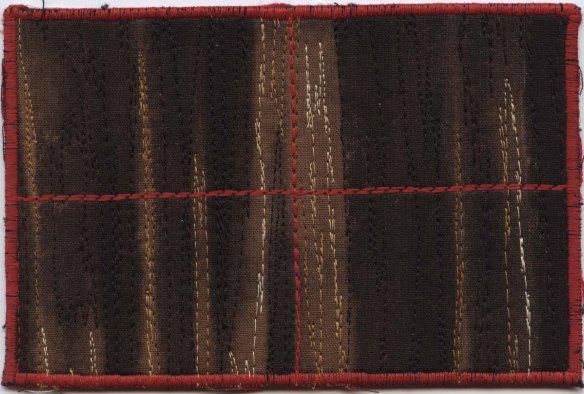 R is for Rhino by Maureen Callahan
R is for Rhino by Maureen Callahan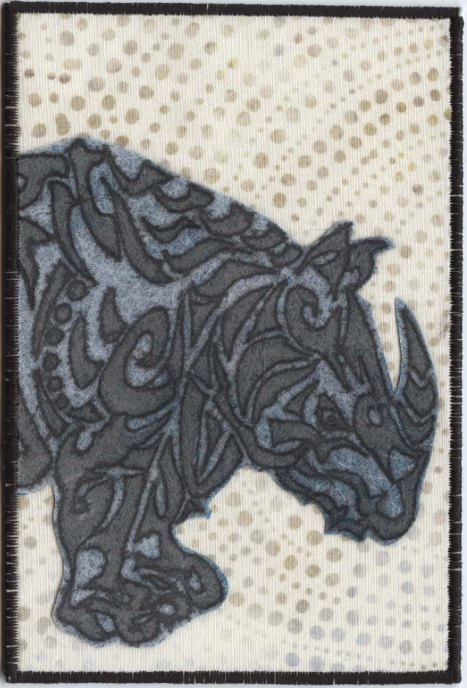 See what other letters of the alphabet inspired here, here, here, and here.
See what other letters of the alphabet inspired here, here, here, and here.
Member Laurie Dhandapani has generously shared her technique for embossing craft foam and using it in making her art. Check it out here.
And if you try this, be sure to come back to us and share your experience.
Each year, Blarney Books and Art in Port Fairy, Victoria, Australia hosts a major competition and exhibition of art made from books. Rita Summers, who was the only Tasmanian entrant this year, submitted Agatha’s Wardrobe, a mixed media artwork incorporating pages from an 1835 publication entitled Agatha’s Husband.
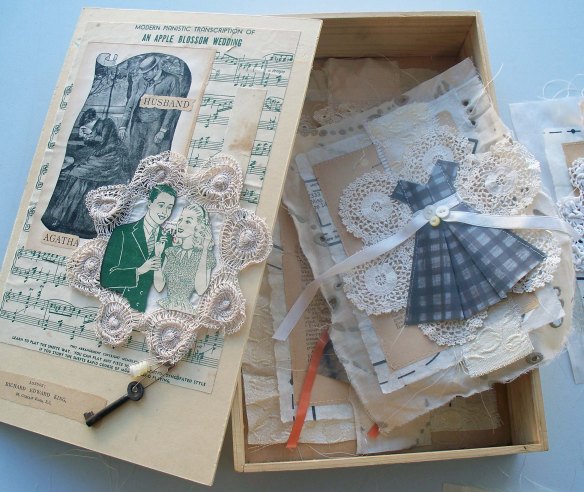 Rita’s entry, described by the judges as a ‘very subtle and emotional piece’, was awarded the grand prize of $1,500. Blarney Books and Art have also purchased Rita’s winning entry for their permanent collection.
Rita’s entry, described by the judges as a ‘very subtle and emotional piece’, was awarded the grand prize of $1,500. Blarney Books and Art have also purchased Rita’s winning entry for their permanent collection.
Art is a way of life for Rita, as can be seen from her original poem, included with her entry:
art is like breathing to me
life and thoughts impressed on paper, cloth, the air
fleeting sounds and images
captured before they escape forever
Rita explains, ‘I like to push the boundaries in my art to create my own original style. My qualifications and background focus on visual contemporary art, craft and design, and stitching is my chosen medium. I often incorporate upcycled materials and found objects. I like to combine a mix of artistic processes: stitching, photography, digital manipulation, printmaking, collage, sculpture, painting, drawing and books or text.’
Agatha’s Wardrobe represents the hopes and dreams of a young woman from the 1800’s as she prepares for her wedding: the shy delight she feels as she chooses her trousseau; the stitching of precious silks and laces for her ‘hope chest’ or ‘glory box’ (probably begun while she was still a child); the anticipation as she tries on her wedding dress; the mystery and uncertainty of love and its passions; the solemnity of the marriage vows.
Love makes us vulnerable to pain, as Agatha discovers. Rita experienced this with her as she read the book and created this artwork. She felt Agatha’s pain as she faced loss, betrayal, isolation, and a deep despair which almost drove her to suicide. Ultimately, love triumphed, but not before it almost destroyed both her and her husband.
There are twelve dresses in the box – a dress for each month of the year. Each dress has a swing label attached to it; each label features a phrase from the traditional marriage vows.
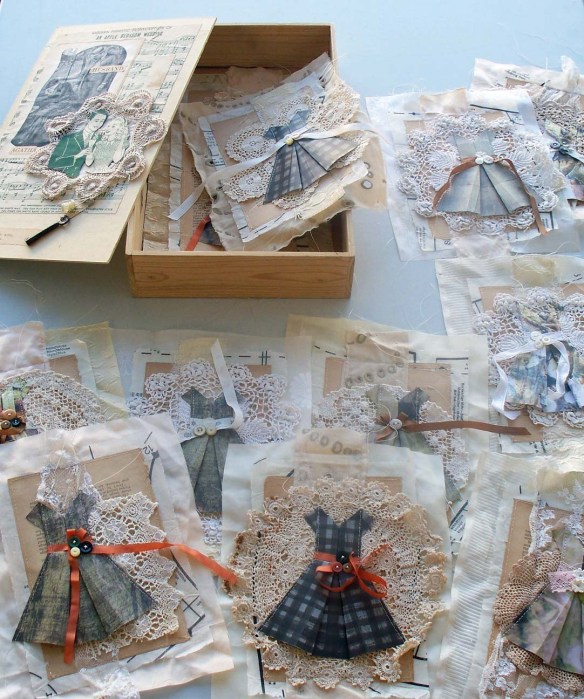 Rita added a key to the box lid as both a symbolic and practical embellishment – ‘the key to my heart’; the key which makes precious items secure; the key which keeps things private.
Rita added a key to the box lid as both a symbolic and practical embellishment – ‘the key to my heart’; the key which makes precious items secure; the key which keeps things private.
Safety pins and buttons – again, both practical and symbolic. Hand crocheted lace, vintage (torn) silk, stitching – everything is given a hidden meaning beyond their intrinsic beauty and structure.
Things hinted at and not always explained. Materials and skills which women have implemented through the ages.
In transforming the original book into something beyond the printed word, Rita hopes that Agatha’s Wardrobe touches the hearts of everyone who sees and absorbs what it has become.
Materials: mixed media – wood, cardboard, vintage silk, found objects, specialty paper, old book pages, old sheet music, vintage lace, buttons, vintage key, dressmaker pattern tissue, stitch
Rita Summers is co-owner and operator of Gone Rustic Studio & Gallery, situated in Tasmania, Australia.
To find out more about Rita and to see more of her art, you can visit her blog at www.gonerustic.com, or her Facebook page www.facebook.com/gonerusticstudiogallery.
This month we are in Connecticut visiting with Jane Davila.
Do you call it a studio or sewing room? To yourself, to friends and family? Why do you think this is so? Difference in starting point between quilting and art? Thinking of this as a business rather than a hobby?
It’s definitely a studio. First because so much more than sewing goes on in there, and secondly because I’m an artist and artists work in studios *smile*. I started out as a printmaker and was introduced to quilting when I joined my mom, Claire Oehler, in the quilt shop she opened in 1990 in Somers, NY, the Country Quilter. My work morphed into art quilts from there, although I usually use either printmaking techniques or paper in my fiber art, as a nod to my beginnings. I earn my living as an author, writer, teacher, editor, designer, and vendor in the quilting industry, so this is definitely a business for me!
What do you have in the room? machines, supplies, fabrics, paints, etc. Anything that might surprise the rest of us?
My studio contains both my art making working space and supplies, and my office and all that entails – printers, filing cabinets, computer, etc. It’s very much a multi-purpose room that, while small, is usually well-organized and well stocked. I also display part of my art collection in this room and like to swap things out periodically to freshen up my view. I don’t think there’s anything surprising in here, but maybe you’d be surprised at all the room holds yet doesn’t feel crowded or too small.
How is your “stuff” organized? How do you organize your fabric? By color? Amount? Any separate categories (batiks, hand dyes)? How do you organize your thread (color, weight)?
After having worked in a quilt store for almost 20 years (we closed when my mom retired 4 years ago), I had quite a substantial fabric collection. I’ve been winnowing it down for the last few years to a much more manageable size. I’ve come to realize that I work small and I’ll most likely always work small, and it’s not super practical to own fabric in 3 yard lengths when most of your work is less than 16” on the longest side. My remaining fabric is organized by color and is neatly folded on bookshelves so I can see what I have. The bookshelves are currently lacking all of their doors, but another trip to Ikea is on my list! I never buy more than a fat quarter of anything now (and even that is big enough for most backs), and if I did need something larger I would probably make a purchase specifically for that purpose. Because the ceilings in our house are 10 feet (just over 3 meters) tall I added extensions to the top of my bookshelves (the ubiquitous Billy from Ikea). I have 6 white metal bins in these extensions and they contain bulky supplies like adhesives, ribbons, pieces of silks and wools, and found objects.
My thread is stored in plastic snap cases for the most part. My favorite thread is Mettler silk-finish cotton so I have 2 cases devoted to that with a spool in each color available. Each case has a slot for each color and all of the slots are labeled so I know when I’m out of a color and can replace it. Not that I’m OCD or anything! Okay, maybe a little.
The paint I use most frequently is in a drawer in my cutting table and the rest of my paint is organized by type and stored in plastic Artbin cases. On the inside of the lid of each box I taped a color chart of the type and brand of paint that box contains. Again, this lets me see what I might be out of so I can easily replace it.
Do you have anything, supplies, more machines, etc. tucked away in any other rooms of the house. How many other rooms? (My husband likes to talk about that one.) Has a family member or significant other ever accused you of “taking over” the entire house? If you have a separate building, we want lots of pictures.
I do have some supplies stored on wooden shelves in the basement. Because I travel to teach, and each workshop needs one or more bins of supplies and samples, there has to be more storage than my one studio can hold. Organizing all of the extra equipment and supplies is an ongoing project. My husband is also an artist and has his own studio in our house too. We coexist very amicably and respect each other’s tools, spaces, and time. He is a sculptor and painter and he works in a very large-scale (typically 4-6 feet and larger) so claiming wall space at home to hang art is a tad competitive! He tends to take the larger open walls and I take the odd small walls and nooks and crannies to hang my work.
How much horizontal surface do you have, and is it ever enough? Do you have to move piles of stuff to cut anything bigger than a fat quarter?
Always! I call it the “Law of Flat Surfaces” which states that as soon as there is a cleared-off flat surface, something will immediately fill it and you will once again be reduced to working in a 12” x 12” space. It doesn’t even really matter how large a space you start with, you always end up with that square foot.
My desk is L shaped and the computer sits on one leg and my sewing machine on the other. Above the sewing machine side of the desk is a bulletin board I made from insulation board covered with linen. Next to the bulletin board are 2 ceramic kitchen organizers hanging on the wall to hold my scissors. Above the computer side are the same organizers with pens, pencils, and paper scissors. I find a lot of good storage ideas in the kitchen department of various stores.
I have a free-standing kitchen island with 12 drawers from Ikea as my cutting table – the height is perfect! Above the cutting table is another piece of insulation board covered in linen that acts as a design wall. I keep my finished quilts (I work small, remember?) in labeled boxes beneath my cutting table.
Next to my cutting table is a door to a closet which contains my husband’s clothes, so no storage there for me! Our house was built in the late 1880’s and has a total of 3, count ’em 3, closets in the entire house. We’ve got to be a little creative with storage. On the outside of this closet door I’ve attached 2 magnetic boards and these hold my calendar for teaching and vending. I use magnetic tape on the back of each month so I can reprint and replace as things change, and so I can remove old months and add new as needed. Almost 2 years in total fits on the door.
Between art projects and office paperwork, there isn’t often a completely clear surface. Sometimes I’ll just spread out on the floor and paint or print.
Do you straighten/organize as you go, putting each fabric away as you cut, or do you clean up after a project? How many projects do you work on at a time and how do you keep them organized?
The cleaning-up-as-you-go approach is my preferred one but it is always dependent on what kind of deadline I’m working under. Tight deadlines mean that messes are usually left to the end to put away. I find that I can’t think in too much clutter and I must stop and put everything back in its place before starting new projects. Otherwise it’s “hello, hives!” Clutter makes me itch.
I used to work on large numbers of projects at one time (lots of samples for the quilt shop, for instance), until we had a huge flood in our previous house due to hurricane Wilma. I literally had every single unfinished project destroyed in one day. Nothing was salvageable. Talk about having the slate wiped clean! I did regret the loss of the projects, the supplies, and the time I put into everything, but I eventually viewed it as a fresh beginning and have only ever worked on one or two things at a time since then. I have nearly no unfinished projects and it’s going to stay that way. After I got over the loss and grieved a little for it, I found it to be unbelievably liberating. I don’t recommend such an extreme approach, but it definitely changed the way I work.
Anything more you want to add about your studio, organization, working methods, etc., please do.
In our previous house I had a separate studio and office and found it much easier to work in either mode because the spaces were in different rooms. In our current house, where there is no room for that separation, I find it much harder to work on my artwork. It’s definitely a mind-set thing and it just doesn’t feel as natural and the work doesn’t “flow” as well here. Over the 2.5 years that we’ve been here I’ve tried changing things as much as I could but didn’t find that any of the changes helped enough.
My husband and I recently made the decision to rent loft space and to combine our two studios into one giant space. We found an old factory building in a nearby town that houses artists’ lofts and independent musicians’ recording studios. We’ve never worked in one space together before, so it should be an interesting challenge; but the space is quite large and my office will remain at home. I’m really looking forward to having a studio devoted to only art again. We just started moving in there and should be completing the move in another few weeks, as we build shelves and tables, etc. I’ll keep you posted on my progress in the new space!
Thank you so much for the tour and the chance to see some of your art. We look forward to seeing your new space.
For more information about Jane’s art, her teaching schedule, and workshops, visit her at www.janedavila.com
Next month: Our member Rita Summers has arranged for us to visit a Tasmanian textile artist.